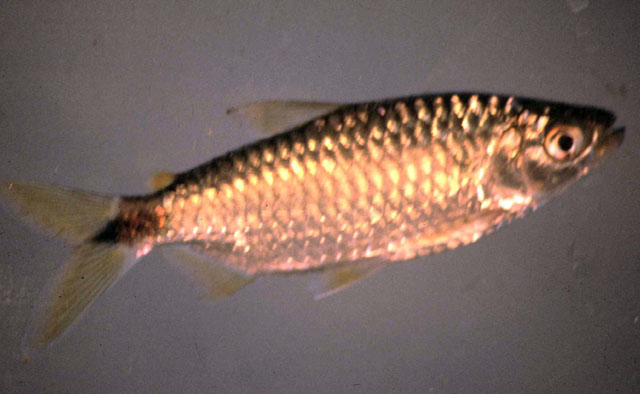| Alestidae (African tetras) |
| 19.8 cm TL (male/unsexed); max.weight: 300.0 g; max. reported age: 5 years |
|
demersal; freshwater; pH range: 6 - 6.5; dH range: 4 - 18, potamodromous |
| Africa: Mono River in Togo to Nipoué River in Liberia (Ref. 2880, 81279). Widely distributed in the Congo River basin (Ref. 42019). Also in the middle Zambezi (Ref. 95585), lower Zambezi, Wami River in Tanzania to Pongolo River in South Africa; Lakes Malawi, Rukwa, Rufiji and Ruvuma; on the western coast in the Quanza and the Nyanga, Tanganyika tributaries, Lake Kariba, Cunene River (Ref. 5331). |
|
Anal spines: 0-0; Anal soft rays: 14-18. Diagnosis: parietal fontanella absent in adults and porelinke in juveniles, disappearing with growth; snout short, comprised over three times in head length; dorsal-fin origin at same level as, or scarcely behind, pelvic-fin insertions; head narrow; adults medium-sized; sexual dimorphism affecting anal-fin shape in adult males; no band or spots on sides; caudal fin red, not black-edged; 4.5 scales between lateral line and dorsal fin; 21-31 lateral line scales; 11-16 anal fin branched rays; 8/8 premaxillary teeth; 16-20 gill rakers in lower part of first branchial arch (Ref. 2880, 81279).
Description: anal fin with 3 branched and 11-16 unbranched rays; jaws equal; premaxilla with two tooth rows, each comprising 8 teeth; in larger individuals, two teeth of the anterior row become dislodged, thus forming a second row (Ref. 2880, 81279).
Colouration: ground colour silvery, back darker (greenish or brownish), belly lighter; black humeral spot; black blotch on caudal peduncle, sometimes extending partially or totally unto caudal-fin rays; colour of fins variable with hydrographic basin: rayed fins yellowish or reddish and adipose fin red (Congo, Ghana, South Africa), paired fins yellow and adipose fin black (Zambezi, Lake Rukwa), rayed fins and adipose fin vermillion red (Côte d'Ivoire and Togo except in Nipoué where species has more brownish fins)(Ref. 2880, 81279). |
| Found in shallow and sheltered waters of swampy bays. Generally restricted to shallow waters where they may be found in various habitats such as over sand, rock or, less frequently, in aquatic weed beds (Ref. 13337). Common in shallow vegetated areas (Ref. 4967). Also found in large rivers and floodplain pans and lagoons. Feeds on insects, tiny fishes, vegetable matters (Ref. 5595) and crustaceans (Ref. 13337). Main predator is the tigerfish (Ref. 7248). Breeds in summer, migrating to spawning sites after rains. Migrates to tributary rivers and floodplains when the rivers come down in spate (Ref. 13337). Known to mass at river mouths while waiting for suitable conditions to trigger off the breeding migrations upstream (Ref. 13337). Used as live bait for tigerfish and large catfish (Ref. 13337). Affinities: B. carolinae, with lateral stripe; B. nigricauda with wide black margin on caudal fin. |
|
Least Concern (LC); Date assessed: 22 May 2018 Ref. (130435)
|
| harmless |
Source and more info: www.fishbase.org. For personal, classroom, and other internal use only. Not for publication.

